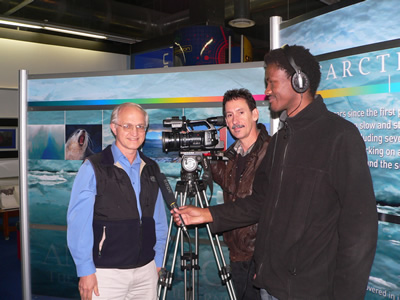| 41% of getS.E.T.go! readers think that the most important benefit of hosting the Square Kilometre Array telescope, would be the boost it gives our international reputation as experts in this field. | |
| 37% opted for “attracting more young people into science and engineering”; and 22% for “foreign investment for local technology projects”. |
Scientists at Stellenbosch University have developed a high-tech "tea bag" filter that fits into the neck of a bottle and turns polluted water into clean water as you drink from it.
Click here to read more.

What would it take to move a person – or their interest – from the hot tropics and “big five” of Africa to the uninhabited, frozen flatness of the Antarctic Circle? These two environments might seem poles apart, but Africa is playing a growing role in the field of polar science, as evidenced during the recent International Polar Year (IPY 2008-09).
Speaking at an IPY Science Conference in Oslo in June, space science researcher Dr Pierre Cilliers presented a paper on South Africa’s role in creating public awareness of research conducted during this period. According to Cilliers, who is based at Hermanus Magnetic Observatory (HMO), IPY-outreach activities have had a significant impact on public interest in the global impact of polar science.
The outreach activities mentioned in his paper included exhibits and activities at science festivals, radio interviews with overwintering scientists in Antarctica and public lectures by polar scientists. The national South African IPY Committee also commissioned a documentary film “Antarctica: Journey into the White Desert”, which depicts life on the Polar Research Ship and at several Antarctic Bases, and which captured the interest of many a young learner in polar science.
Cilliers added that popular science articles were written about African involvement in Polar Science. Several African countries also sent expedition members to Antarctica for the first time ever during IPY, which had a great public appeal.
In particular, Cilliers’ presentation highlighted the role played by SAASTA and HMO and focused on the methods used and impacts achieved through the integration of research with outreach and science communication by polar researchers and SAASTA. It also outlined HMO’s key role in the Polar Space Weather Studies during IPY/IHY project, in support of the ICESTAR/IHY research initiative into geospace phenomena.
The paper, titled Inspiring Young South African Learners through Exposure to IPY Science was co-authored by Elisa Fraser, manager of science advancement at HMO.
Cilliers added that the interactive IPY exhibits at science festivals were popular, and teaching opportunities had subsequently been developed along IPY-themes. The documentary film is still being used for public outreach and the training and orientation of Antarctic expedition members.

Dr Pierre Cilliers (left) of the Hermanus Magnetic Observatory, during an interview with the media.
